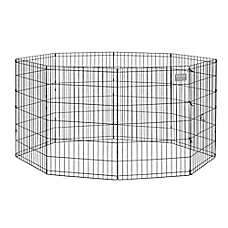Containing Your Canine: Dog Gates and Pens

In this Article
Pressure-mounted gates
Consider a pressure-mounted gate if you:
- Want a simple solution that doesn’t require tools or hardware to set up
- Plan to move the gate from room to room
- Want to block off angled openings
- Have a dog who tends to squeeze through tight spaces
Hardware-mounted gates
Consider a hardware-mounted gate if you:
- Have a dog who tends to knock things over
- Don’t mind using hardware and tools to secure the gate to a solid door frame
- Don’t plan to move the gate often
- Need a gate at the top of a staircase
Free-standing gates
Consider a free-standing gate if you:
- Have a small to mid-sized dog
- Have a dog who won’t jump over or knock down an obstacle
- Need a gate that’s easily portable
- Need your gate to span a wide entrance or your walls won’t support a pressure- or hardware-mounted gate
- Aren’t using your gate to block off a staircase
Exercise pens
Consider an exercise pen if you:
- Need a temporary area to contain your dog that’s more portable than a crate
- Want to add contained “lounging” space to his crate or sleeping spot
- Want to include your dog in outdoor activities — but don’t want to give him the run of the yard
- Need to contain more than one dog
- Need to give your dog a safe environment to dry off after a bath or recovery from an injury
Wood, metal or plastic?
Dog pens and gates come in different materials. Consider wood if you like its look, light weight and durability. If your pup is a heavy chewer, however, you might consider plastic or metal. While plastic is likely to be the most affordable material, a metal pen or gate is sturdier, for those dog parents raising canine escape artists.


